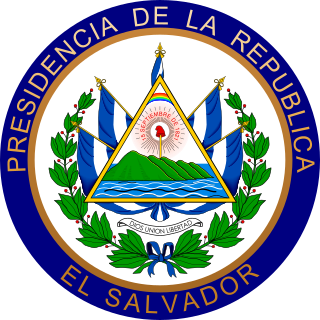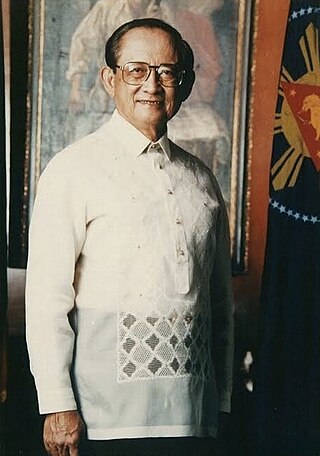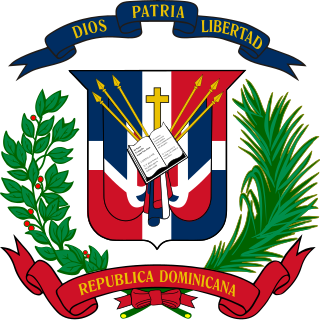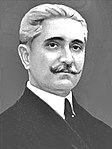
The president of the Republic of El Salvador is the head of state and head of government of El Salvador. The president is also the commander-in-chief of the Armed Forces of El Salvador.
The Liberal Party of Cuba, was one of the major political parties in Cuba from 1910 until the Cuban Revolution in the late 1950s, when it was exiled.

Bulgaria elects a head of state—the president—and a legislature on a national level. The president is elected for a five-year term by the people directly. The National Assembly has 240 members elected for a four-year term by proportional representation in multi-seat constituencies with a 4% threshold. Bulgaria has a multi-party system in which usually no party receives a required majority and parties have to collaborate to form governments, generally via confidence and supply or coalition agreements.
This list of presidential elections in the Philippines includes election results of both presidential and vice presidential elections since 1899 with the candidates' political party and their corresponding percentage.

Presidential elections were held in Brazil on 1 March 1906. The presidential elections were won by Afonso Pena of the Mineiro Republican Party, who received 98% of the vote. Nilo Peçanha of the Fluminense Republican Party was elected vice president, also receiving 98% of the vote.

The 1969 Philippine presidential and vice presidential elections were held on November 11, 1969. Incumbent President Ferdinand Marcos won a second full term as President of the Philippines. Marcos was the last president in the entire electoral history of the Philippines who ran for and won a second term. His running mate, incumbent Vice President Fernando Lopez, was also elected to a third full term as Vice President of the Philippines. A total of twelve candidates ran for president, but ten of those got less than 0.01% of the vote.

The 1965 Philippine presidential and vice presidential elections were held on November 9, 1965. Incumbent President Diosdado Macapagal lost his opportunity to get a second full term as president of the Philippines to Senate President Ferdinand Marcos. His running mate, Senator Gerardo Roxas, lost to former vice president Fernando Lopez. Emmanuel Pelaez, who resigned in the Cabinet and from the Liberal Party, then sought the Nacionalista Party presidential nomination and lost it to Marcos, did not run for vice president and instead ran for the Misamis Oriental seat in the House of Representatives as an independent. An unprecedented twelve candidates ran for president; however, nine of those each garnered less than 200 votes.

The 1961 Philippine presidential and vice presidential elections were held on November 14, 1961. Incumbent president Carlos P. Garcia lost his opportunity for a second full term as president of the Philippines to Vice President Diosdado Macapagal. His running mate, Senator Gil J. Puyat, lost to Senator Emmanuel Pelaez. Six candidates ran for president, four of whom got nine votes nationwide together. This was the only election in Philippine electoral history in which a vice-president defeated the incumbent president.

The 1957 Philippine presidential and vice presidential elections were held on November 12, 1957. Incumbent President and Vice President to Ramon Magsaysay, Carlos P. Garcia was elected for a full term as President of the Philippines. Garcia assumed the post following the death of Magsaysay in a plane crash earlier that year. His running mate, Speaker Jose Laurel Jr., lost to Pampanga Representative Diosdado Macapagal. This was the first time in Philippine electoral history wherein a president was elected by a plurality rather than a majority, and in which the winning presidential and vice presidential candidates came from different parties.

The 1953 Philippine presidential and vice presidential elections were held on November 10, 1953. Former Defense Secretary Ramon Magsaysay was elected President of the Philippines, defeating Incumbent Elpidio Quirino in his run for a second full term. His running mate Senator Carlos P. Garcia defeated Quirino's running mate Senator José Yulo. Incumbent Vice President Fernando Lopez did not run for re-election. With Magsaysay's election as president, he became the first elected president that did not come from the Senate.
Presidential, legislative, and local elections were held on November 8, 1949 in the Philippines. Incumbent President Elpidio Quirino won a full term as President of the Philippines after the death of late President Manuel Roxas in 1948. His running mate, Senator Fernando Lopez won as Vice President. Despite factions created in the administration party, Quirino won a satisfactory vote from the public. It was the only time in Philippine history where the duly elected president, vice president and senators all came from the same party, the Liberal Party.
Presidential, legislative and local elections were held on November 14, 1961 in the Philippines. Incumbent President Carlos P. Garcia lost his opportunity for a second full term as President of the Philippines to Vice President President Diosdado Macapagal. His running mate, Senator Gil J. Puyat lost to Senator Emmanuel Pelaez. Independent Candidate Cebu City Mayor Sergio Osmeña, Jr. ran for Vice President also lost by a narrow margin. Six candidates ran for president, four of whom were "nuisance" candidates. This was the only election in Philippine electoral history in which a vice-president defeated the incumbent president.
Presidential, legislative and local elections were held on November 11, 1969, in the Philippines. Incumbent President Ferdinand Marcos won an unprecedented second full term as President of the Philippines. Marcos was the last president in the entire electoral history who ran and won for a second term. His running mate, incumbent Vice President Fernando Lopez was also elected to a third full term as Vice President of the Philippines. An unprecedented twelve candidates ran for president, however ten of those were nuisance candidates.

Presidential and vice presidential elections, legislative elections and local elections were held in the Philippines on May 11, 1992. An estimated 80,000 candidates ran for 17,000 posts from the presidency down to municipal councillors in the first general election under the 1987 Constitution. Even though she was permitted by the Constitution to run for a second term, President Corazon Aquino did not stand for re-election.

Presidential elections, legislative and local elections were held in the Philippines on May 11, 1998. In the presidential election, Vice President Joseph Estrada won a six-year term as president by a landslide victory. In the vice-presidential race, Senator Gloria Macapagal Arroyo won a six-year term as vice president also by a landslide victory. This was the third election where both president and vice president came from different parties.

General elections were held in Costa Rica on 4 October 1949. They followed the introduction of a new constitution after the Costa Rican Civil War. Voters elected a vice president and the Legislative Assembly. The result was a victory for the National Unity Party, which received 72% of the vote. Voter turnout was 44% in the vice presidential election and 49% in the parliamentary election.

General elections were held in the Dominican Republic on 16 May 1957. Incumbent Héctor Trujillo was the only candidate in the presidential election, and was unopposed for a second term. However, his predecessor and brother Rafael Trujillo, the country's de facto leader since 1930, maintained absolute control of the country. The Dominican Party won every seat in the Congressional elections.
Presidential elections were held in Colombia in February 1922. The result was a victory for Pedro Nel Ospina of the Conservative Party, who received 62% of the vote. He took office on 7 August.

Events in the year 1922 in Brazil.
Presidential elections were held in El Salvador in January 1895. General Rafael Antonio Gutiérrez, who was serving as the country's provisional president during the election, ran unopposed and was elected with over 99 percent of the vote. Concurrent vice presidential elections were held, during which, Prudencio Alfaro defeated Carlos Meléndez and four minor candidates.

















